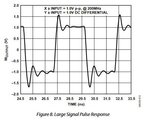Smillsey
Member level 5
Hi all
I am looking for a fast analog signal “chopper”. Basically an analog switch
I would like to “chop” a signal with 50% duty up to a frequency of around 90MHz.
in an ideal world the input signal would be switched from its current level to zero in as short a time as possible, remain at that level and then switch back to the pre “switched” level - this switching will be controlled by a square wave generated from an FPGA.
At the moment I am looking at the following switch;
I can’t find a faster analog switch, do you think I can find one? Am I looking in the wrong places?
thanks
I am looking for a fast analog signal “chopper”. Basically an analog switch
I would like to “chop” a signal with 50% duty up to a frequency of around 90MHz.
in an ideal world the input signal would be switched from its current level to zero in as short a time as possible, remain at that level and then switch back to the pre “switched” level - this switching will be controlled by a square wave generated from an FPGA.
At the moment I am looking at the following switch;
I can’t find a faster analog switch, do you think I can find one? Am I looking in the wrong places?
thanks
